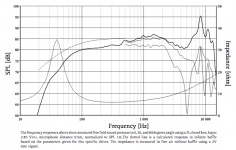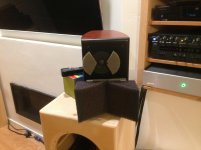I am not an amplifier expert by any means. I posted this as most (including myself) generally assume the majority prefer low levels of H2 over H3 distortion. The driver and amplifier are separate parts of a chain, with HD from both devices having an impact. Of course the amplifier in most cases (single ended tube amplifiers excluded) should have significantly lower HD, so its HD impact should be less than the driver.
Last edited:
In my personal, not-backed-by-science view, not more than the following with loud-ish music at listening position:
- 30-40 dB H2
- 45-50 dB H3
- 60-65 dB H4
- 65-70 dB H5
Thanks to you.
FWIW, I tried what HifiCompass advised 5 years ago maybe with a mid and tweeter aluminium speaker... just -5db notch iirc around 3500 hz on the overlapp and a little large, I mean not a stiff notch. I believed it was going to kill all transcient behavior and clearness... but not at all ! Yes it works, huge improvment for me... needed some little try and errors though with the LCR parts values.
The first of six reviews of SB Acoustics speakers:
The review of SB Acoustics SB21SDCN-C000-4 and SB21RDCN-C000-4 tweeters | HiFiCompass
The review of SB Acoustics SB21SDCN-C000-4 and SB21RDCN-C000-4 tweeters | HiFiCompass
In my personal, not-backed-by-science view, not more than the following with loud-ish music at listening position:
- 30-40 dB H2
- 45-50 dB H3
- 60-65 dB H4
- 65-70 dB H5
I have it from an well informed source that its is the 7:th that is the real killer - and very low levels are still bad. No joke.
//
Thank you!The first of six reviews of SB Acoustics speakers:
The review of SB Acoustics SB21SDCN-C000-4 and SB21RDCN-C000-4 tweeters | HiFiCompass
Yes, of course. The notch can down 3rd and 5th HD peaks corresponding to the breakup resonance as much as the peak is attenuated. This distortion is born in a speaker's motor and manifests itself as a distortion voltage source in the voice coil circuit. This voltage source creates the voice coil current, which drives the voice coil and is subjected to the resonance amplification by the cone at the breakup frequency. You need to break circuit for voice coil current at breakup frequency by adding hi-impedance notch in series with the voice coil. It really works.
Here I thought we were condemned to live with motor distortion on high-Q peaks. Learn something new every day, nifty.
Here's something else one could try:
Since dispersion on almost every driver decreases as frequency rises, it's not a far road to imagine higher frequency resonances would fall off away from the azimuth, for example as with the Seas 15cy001. From the spec sheet we see the on-axis peak is about 10 dB above the midband response, whereas it's at the same level 30 degrees off axis.

Now we could try increasing the dispersion above the midband with an acoustic lens such as the arrangement here, where the foam pieces act as a divergent lens mostly above 2 kHz. An entirely unscientific no-blind listening test hints at slightly smoother upper mids on Dayton RS150s, so once I clear away the rubble my next homework is getting distortion charts with & without lenses.

If someone wants to try experimenting with the same foam, I used this. It's originally intended for keeping leaves from gutters, featuring open-cell construction to keep water draining through it. Reviews for that function aren't great, but it seems to work a treat for audio! In North America Ace Hardware has some in stock.
Last edited:
If the distortion products are going to be out of passband, you can just cover the whole driver with (thin) absorber. That is, if you have access to DSP, as your name suggests, to EQ any possible attenuation at the upper end of driver passband.
Last edited:
If the distortion products are going to be out of passband, you can just cover the whole driver with (thin) absorber. That is, if you have access to DSP, as your name suggests, to EQ any possible attenuation at the upper end of driver passband.
You could do that. The difference between top of passband and resonance peak is typically less than two octaves, however, so the cover would need careful designing so it doesn't screw up the passband since the driver shouldn't be equalised too hard lest distortion products rise and then you're right back where you started.
Absorbing material tends to be denser than open cell foam, too, so one must take care to avoid setting up a resonant chamber between the cone and the absorber. Guess how I know that one? 😛
... so you're more on absorber around than in front of the cone ? a foam round pad in front of the dust cap is attracting me... staying in place with wires tied on the screws of the driver basket !
Boston Acoustics Lynnfield 300L Series II loudspeaker | Stereophile.com Slighty OT.
Thanks HifiCompass for the measurements of the two tweeters and also for your subjective hearing test.
Was asking myself if those little tweeters can be helped on the sound rendition by a LCR notch on the FS peak or a little above - but keeping the 3k hz and up advised XO ?
12db filters will do or you advise higher slope with all those little domes with higher FS ?
Boston Acoustics Lynnfield 300L Series II loudspeaker | Stereophile.com Slighty OT.
Thanks HifiCompass for the measurements of the two tweeters and also for your subjective hearing test.
Was asking myself if those little tweeters can be helped on the sound rendition by a LCR notch on the FS peak or a little above - but keeping the 3k hz and up advised XO ?
12db filters will do or you advise higher slope with all those little domes with higher FS ?
Last edited:
Infinity made fabulous sounding speakers with dome midranges -great review Compass - keen to try this midrange. I must admit I thought it would be better measuring than your results show - especially with price factored in
Last edited:
yes... a whopping huge 5 inch dome which was reinforced with a carbon fiber lattice-type structure... totally unique. If I recall, Infinity operated it from 90 Hz (!!!) up to about 3 k.
I still own the Kappa 9 -5inch with lattice 80 hz to 800hz crossing to 3 inch polydome 800 to 4.5 khz. Not perfect but very musical. Main fault was expensive amps to sound best. I think low distortion is now a priority for me so the dome midrange may be a pass. Purifi midbass to tweeter would result in a cleaner sound. Food for thought in Australia these are quite expensive drivers - I am struggling to see a benefit over some of the alternatives ��
Thanks much!
Seeing as how the voice coil current distortion is only slightly lower than the measured acoustic distortion, I'd bet a buck this driver could benefit from a current drive amplifier in a multi-amped setup. With a passive crossover, given its high sensitivity, a hefty series resistor could accomplish much the same thing. Bonus round: constant current drive would essentially flatten the frequency response curve down to 500 Hz, and here the resistor might do a slightly better job.
A look at the Menara impedance curve shows the MD60's range is about 10 ohms instead of 6, which hints at around 4 ohms series resistance in that system's crossover.
Infinity Kappa Serie
they had a lot of speakers using dome midranges. The polygraph was the 5 inch quite unique
they had a lot of speakers using dome midranges. The polygraph was the 5 inch quite unique
Thank you very much for the review as always ! I was really curious about this driver. Now I am looking forward to seeing the Textreme MW16 and MW19 reviews 🙂
As far as the MD60 is concerned, well, it is certainly pretty good at what it is designed to achieve. But in all honesty, in comparison, the little Scanspeak 4424 has/is :
- Around the same SD (36cm²)
- Smaller faceplate : 98mm vs 130mm
- Slightly better distorsion figures
- Better/wider directivity
- More extended in the lows and highs
- More Xmax (2.6mm vs 0.5mm)
- Less expensive (~100€ vs ~170€)
As far as the MD60 is concerned, well, it is certainly pretty good at what it is designed to achieve. But in all honesty, in comparison, the little Scanspeak 4424 has/is :
- Around the same SD (36cm²)
- Smaller faceplate : 98mm vs 130mm
- Slightly better distorsion figures
- Better/wider directivity
- More extended in the lows and highs
- More Xmax (2.6mm vs 0.5mm)
- Less expensive (~100€ vs ~170€)
It is very sensitive, so that's a plus. But that resonance at 1500Hz and the price kills it for me.
Last edited:
- Home
- Loudspeakers
- Multi-Way
- Some speaker driver measurements...